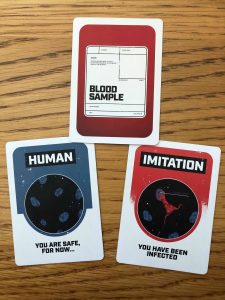Photo by Valentin Salja on Unsplash
Table of Contents
- What is The Thing: Infection at Outpost 31?
- A Quick Overview of How the Game Works
- Strategies for Players Who are Imitations
- Wrap Up
Social deduction games are a blast. They force you to really look at everyone around the table, wondering who is and who isn’t on your side. Not everyone is who they say they are in games like this, which heightens the tension and forces you to use your brain.
I’d like to talk about one of my favorite ones today, Infection at Outpost 31. More specifically, I’d like to describe some strategies you can utilize if you’re the odd one out: the Imitation.
I know the first time I played it, I was super confused about what to do as an Imitation. Although I ended up winning (kind of by a fluke, actually), I had no idea what was going on or what strategies to use.
I’ve played it quite a few times since then, and I’d like to show you some strategies that have worked well for me. That way, if you’re ever in the same boat as an imitation, you won’t be left floundering in confusion.
What is The Thing: Infection at Outpost 31?

Let’s take a couple steps back and introduce this fantastic game first. At its heart, The Thing: Infection at Outpost 31 is a social deduction game based on an old sci-fi horror movie.
Social deduction games are board games that are cooperative, meaning players must work together to complete some objective. However, one or more players in the group are hidden traitors, striving to achieve their own concealed objectives at the same time – to the detriment of the whole group.
Perhaps the perfect setup for a game like this was John Carpenter’s The Thing. The 1982 cult classic horror movie takes place on an arctic research base that has discovered the remains of a shapeshifting alien. As the movie progresses, the characters begin to wonder who among them is human, and who among them is a monstrous entity simply wearing the mask of someone they once knew.
It’s little wonder, then, that someone ended up making a social deduction board game based on this phenomenal premise: Infection at Outpost 31.
A Quick Overview of How the Game Works

The premise of the game is that all human players are trying to escape the research base after discovering the presence of the nefarious alien. To do so, they must go through different areas of the station, completing goals listed on Mission Log cards. Usually, these goals just require the players to have certain types of Supply cards.
Each turn, a new player gets to be the Captain, who picks a team from among the others and decides which area they’re going to explore next. With their crew, they go to the chosen room, attempt to gather the supplies listed on the Mission Log card, and GTFO.
Once they progress through all the areas on the board, they have the chance to escape on the helicopter. Sounds easy enough, right? Well, here’s the catch: the entire time, one or more players are Imitations.
Whoever gets the role of Imitation is randomly selected at the beginning of the game by getting a blood test card that says Imitation on it. Blood Sample cards are handed out three times in the game, so potentially more players are “infected” as they reach new areas on the board.
The Imitations don’t want the humans to escape. Or, if the humans do escape, the Imitations want to make sure they’re on that helicopter, too, ready to infect the rest of humanity.
On the last turn of the game, the final Captain must pick who gets to escape, and he or she can’t pick everyone. The number of people allowed on the helicopter varies based on the total number of players. The bottom line is, a couple people will likely need to be left behind, and the Captain needs to make sure they don’t take an Imitation on board.
This is a really basic overview of the game. If you’d like a more detailed one, check out the below video.
Strategies for Players Who are Imitations
Playing an Imitation is a difficult role. It’s easy to be a human, because you’re always guaranteed to have people working with you, whether or not you think you can trust them.
That’s why I’m providing you the following strategies. I’ve listed them in order from easiest to what I feel is the hardest. Stick to the easy or medium strategies if you’re a beginner.
Anyway, here are my recommendations:
Easy: Lay low.
By far, the easiest (and most boring) Imitation strategy is just to lay low. Here’s all you need to do:
- Don’t attempt to sabotage missions.
- Avoid drawing any sort of attention to yourself.
- If anyone asks, insist you’re human and act shocked that anyone would suggest otherwise.
You’ll need a good poker face for this strategy, and that’s about it. Play along with the rest of the human players, legitimately trying to help them complete missions.
By the end of the game, you should hopefully be as unsuspicious as possible and have earned the trust of the human players. If you’re lucky, they’ll pick you to be the final Captain, which means you’ve basically won the game because you’re guaranteed a spot on the helicopter.
Otherwise, if you’re not the final Captain, simply sit back and hope that you get picked for a spot in the escape.
Medium: Good cop/bad cop.

I’m ranking this strategy as medium, because you’ll need to be sure that at least one other player is an Imitation in order to do it. Of course, when everyone is insisting that they’re human, it can be impossible to tell who’s on your side.
You’ll at least be able to be 100% sure when there’s another Imitation, though…even if you don’t know who they are. As your group progresses to new areas on the base (there are three total), new Blood Test cards will be handed out. Provided you don’t get another Imitation card at these points, you can be sure someone else did and was consequently infected.
That’s when you roll out the good cop/bad cop act. It’s pretty simple from here on out: one of the Imitations starts behaving obviously suspiciously. They sabotage missions, contradict themselves, and if they’re a good actor, they might look nervous or cocky.
Their goal, in other words, is to draw attention so other Imitations can slip under the radar.
This strategy is absolutely deadly when executed properly. The problem with it, however, is that it’s hard to coordinate. Remember, you don’t want to reveal your status as an Imitation, and other Imitations don’t want to, either.
Because others are unsure of who to trust, you might find yourself all doing the lay low strategy without any coordination. Worse still, two of you might decide to be the distraction at the same time, making the identities of a couple Imitations obvious to the human players.
Hard: Sneaky saboteur.

Sneaky saboteur is a good solo strategy if you’re too cautious to attempt covert coordination with other Imitations. I’m calling it hard, though, because it’s difficult to do without getting caught.
Your goal with this strategy is to actively sabotage the team in as subtle a way as possible. One way to do this is by using Sabotage cards on occasional missions, then playing it straight on others.
Another subtler option is to just be the greatest dead weight you can be. On missions, insist you don’t have the right cards to complete the objective, turning in supplies that are useless.
If you’re the Captain for a turn, sabotaging missions is a piece of cake. Some characters get a special ability that allows them to discard Supply cards and draw new ones on missions. Should you have that ability, you can say there’s a Sabotage card in the pile even when there isn’t and draw a new one, hoping to actually get a Sabotage.
This pairs especially well with my next strategy…
Hard: Backstabber.
In one game I played, the Imitation used this strategy and left us stunned when she won. Backstabber works best when you’re playing with people you know well, so you have an understanding of the group dynamic. However, you could do it with people you’re not as familiar with, too, provided you’ve got some solid bluffing skills.
With this strategy, your goal is to pick one or two people in the group as your scapegoats. These are going to be the people you’ll work to cast suspicion on for the entire game.
How? Well, it will take time to build up. Whenever you’re on a mission with them, play a Sabotage card, for instance, and try to look suitably surprised when the Captain mentions it. While doing it every time you’re on a mission with them would look too obvious, make sure you do this every so often to make them look just slightly wrong.
Question your scapegoat’s motives. Ask them to talk about which cards they played for specific Missions. Should you get the opportunity to give them a blood test later, lie about the results and tell everyone else they’re an Imitation.
It’s a vicious tactic. Best of all, it’s even more effective when you know the players around the table and understand which ones the others are more likely to doubt.
The reason why it’s hard is that you’re at risk when you do it. This strategy requires a delicate balance; cry wolf too loudly, and you’ll be the one who looks untrustworthy. Furthermore, if someone else can test the blood of your scapegoat and they’re revealed to be human, other players will wonder why you blamed them so often.
Wrap Up
The Thing: Infection at Outpost 31 is an absolute blast. Even people who aren’t normally fans of horror seem to like this game, because it really gets you thinking.
Unfortunately, it’s not very easy to find anymore. My understanding is that it was only in production for a limited amount of time, but I’m not 100% sure. If you’re able to get your hands on it, I definitely recommend it. And if you happen to try one of my strategies as a result, I wish you the best of luck.
